Moths are generally associated with unicolor insects. But moths come in various shapes and colors. Some of them are known to resemble various species of bees and wasps.
The following species are even confused with either bees or wasps.
Table of Contents
1. Polka-Dot Wasp Moth
The Polka-Dot Wasp Moth (Syntomeida epilais) shows mimicry attributes resembling a wasp. It’s mostly found in the Southeastern states.
Often believed to be dangerous, this moth is harmless.
It’s identified by its thick black body, black wings, and orange end of the abdomen. It also shows white dots on its wings that inspire its name.
This moth species is categorized as a pest. Its larvae feed on oleander plants.

However, it’s believed this moth hasn’t always been interested in oleander plants before they were introduced to North America by Europeans from Spain.
These moths have previously been seen as pests of Devil’s potato plants which they can still be seen around today.
2. Black-banded Wasp Moth
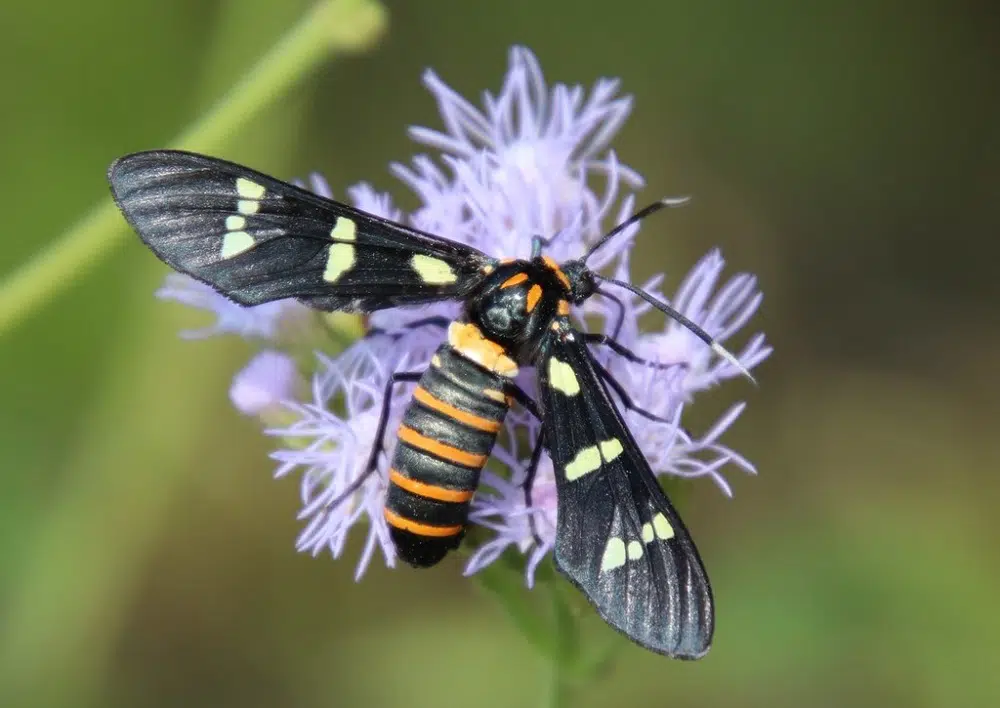
Black-banded Wasp Moths (Syntomeida melanthus) are common in Southern areas of Arizona and Texas.
They are mostly seen in the summer around bindweed.
This is a species of moth that resembles a series of black and orange wasps. It has a mostly black body.
Its abdomen shows distinct parallel orange stripes while its black wings show a few yellow dots.
The species is believed to show mimicry habits as it tries to avoid being predated. It’s a daytime moth.
3. Lilac Borer Moth
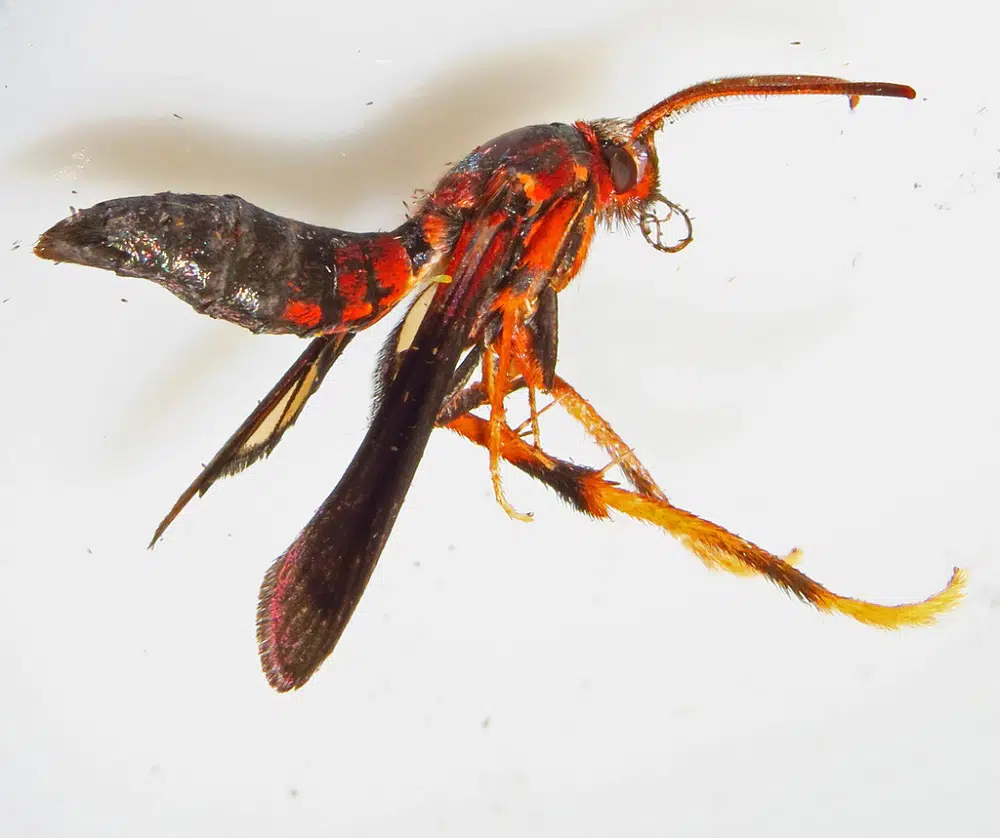
The Lilac Bored (Podosesia syringae) is sometimes called Ash Borer.
This species is known for having transparent wings with a wingspan of just over an inch. With a black or dark color body, these moths mimic paper wasps.
These moths mimic wasps that lay eggs directly or under tree bark. This is why they can sometimes be confused with paper wasps.
Lilac Borer Moths have known pests of ash trees common in North America.
Since they leg eggs in the tree bark they can trigger infestations. Ash trees die when too many moths lay eggs under their bark.
The use of insecticides is a common solution against these moths and other wasps that might damage ash trees.
4. Texas Wasp moth

First described in 1793, the Texas Wasp moth (Horama panthalon) is one of the oldest recorded species on US territory. It has since expanded in Central America.
The Texas Wasp moth is now found in Northern Mexico as well as in Baja California.
Most common in Texas, it’s also occasionally seen in Florida. The Texas wasp moth also mimics paper wasps.
The species has a reduced presence in other states such as Arizona and Missouri.
Its body is orange and brown with black stripes. Its wings are brown.
This species has a wingspan that ranges from 32 to 41mm.
Often seen around the day, the paper wasp-mimicking moth is attracted to flowers. Eupatorium flowers such as asters are mostly of interest to the Texas wasp moth.
The lifespan of these moths expands to a year.
5. Snowberry Clearwing

The Snowberry Clearwing (Hemaris diffinis) is also known as the Hummingbird moth.
A black and yellow body with a wingspan of up to 51mm highly resembles the look of native bumblebees.
This moth species is highly common in parts of North America, particularly in the US side of California.
It also has a numerous population in other Southern states to Florida.
This moth also has similar flight trajectories as bumblebees which can make it even more confusing to separate the species.
One of the easiest ways to tell it apart from real bumblebees is by its transparent stripped wings which are more transparent than the wings of most bumblebees.
The moth shows the most activity during the day. It only shows nocturnal habits when there are numerous food sources around.
Adult moths are mostly seen during the day. They forage species such as mint, honeysuckle, dogbane, and cherry trees.
6. Strawberry Crown Moth

The Strawberry Crown Moth (Synanthedon bibionipennis) is common in North America, particularly in Western Regions of the US.
Seen as a strawberry pest, the moth can be found in high numbers in agricultural fields and greenhouses.
The species is characterized by a large body that emerges in the spring after the eggs overwinter at the base of strawberries and other plants.
Known for its black and white banded body, this moth resembles multiple species of black and white-banded wasps.
7. Broad-bordered Bee Hawkmoth

Mimicking bumblebees, Broad-bordered Bee Hawmoths (Hemaris fuciformis) have brown, black, and white coloring.
They have transparent wings with red coloring on the edges.
Part of the hawk moth group, the species is considerably larger than the bees it mimics.
Typical wingspan sits at just over 40mm reaching a maximum of 48mm.
Larger than bumblebees, Broad-bordered Bee Hawkmoths are also faster and more accurate fliers. They feed on a wide range of plants.
Flight season is very short being one of the moth species that look like wasps that is the most difficult to see through the summer. It only flies between May and June.
The species is common in North America and Europe.
8. Scarlet-bodied Wasp Moth

This moth (Cosmosoma myrodora) is identified by a vivid red coloring and long transparent wings.
Like many moths that look like bees, the Scarlet-bodied Wasp moth has black edge coloring on the wings.
It’s found in coastal regions of the US and it has a long flight season in states such as Florida.
Bright red coloring makes this wasp stand out in any environment.
It’s known for visiting a series of flowers such as dog fennel. These moths are also seen on hempvine.
Some of the moths are also seen climbing hempweed in Florida.
9. Gardenia Bee Hawk

Gardenia Bee Hawks (Cephonodes kingii) live in most areas of Australia.
Their physical appearance mimics the appearance of bumblebees even if the moths are larger.
Individuals of the Gardenia Bee Hawk species have a wingspan of around 40mm.
Distinct physical traits include a mostly green body with a yellow abdomen. These moths also have a black band on the upper side of the abdomen.
The species gets its name from eating the common gardenia flower. Gardenias are evergreen flowers that attract these moths throughout the year.
Gardenia Bee Hawks are also interested in other flowers such as Supple Jack.
10. Raspberry Crown Borer

The Raspberry Crown Borer (Pennisetia marginatum) is known for eating raspberries and blackberries. This is a moth species that mostly resembles yellowjackets.
Raspberry Crown Borer moths have a black and yellow banded body, similarly to the body and appearance of yellowjackets.
Mimicry specifics are also seen in the size of these moths as they are smaller and more similar to yellowjackets. Raspberry Crown Borers moths are up to 16mm long with a wingspan between 18 and 25mm.
These moths are common in the US. They are found in coastal regions where they are seen on various fruit-bearing plants.
It takes as long as 2 years for these moths to mature. In this time, they can cause damage to canes.
These moths have often been seen nesting in the ground and they can become a pest when found around homes.
Insecticides are often used in the fall to control the spread of Raspberry Crown Borer populations.
11. Rocky Mountain Clearwing
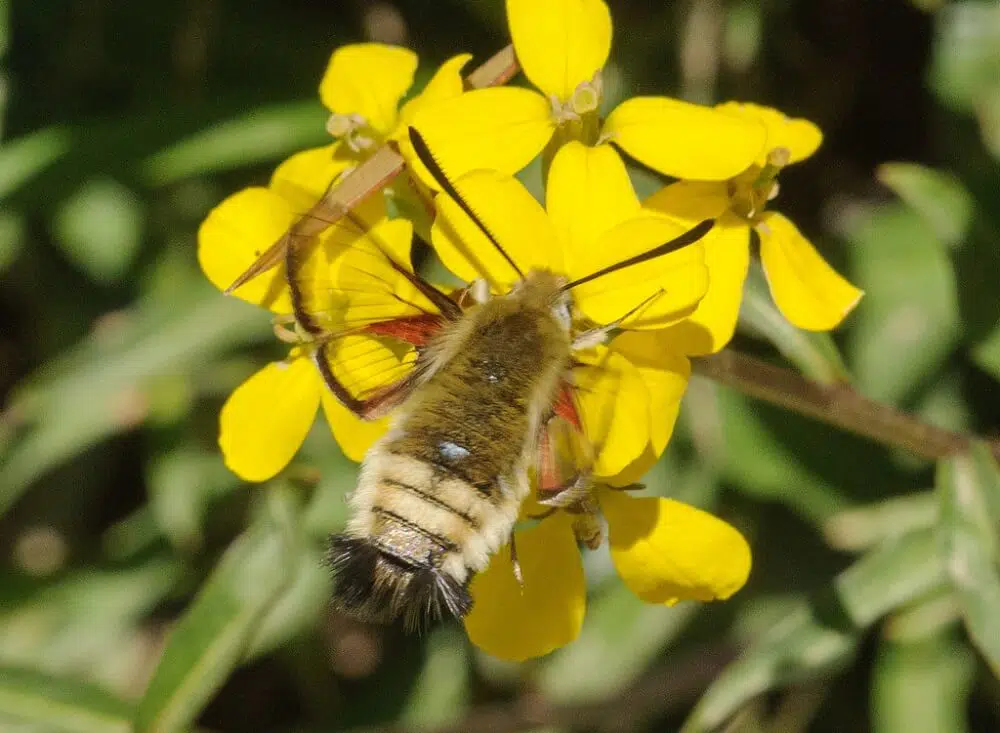
The Rocky Mountain Clearwing (Hemaris thetis) is a moth species known for its adaptability in high terrains.
It lives up in mountains where it finds unique wildflowers of the Arctostaphylos uva-ursi genus.
The species resemble bumblebees with a hairy golden body with black bands on the thorax and abdomen.
Its wings are mostly transparent, as with most moths that look like wasps.
Flight season is determined by warm summer weather. Since it lives on the West Coast, this species is mostly limited to the May-August flight season.
Larvae and adults feed on different plants.
While adults prefer Arctostaphylos genus flowers, larvae only consume Symphoricarpos, also known as snowberry or waxberry.
All of these flowers are known to live in shrubs. This is the reason why spotting these moths out in nature isn’t common as they hide through flower shrubs.
12. Squash Vine Borer Moth

The Squash Vine Borer Moth (Melittia cucurbitae) gets its name from living and eating squash flowers. Known as invasive species, these moths look like wasps.
Bright orange coloring and black marks characterize the body of the species. Its wings and antennae are black.
Wingspan can measure as much as 38mm.
These moths spend all their lives around various species of squash such as butternut and Hubbard.
Common in the US, they develop inside the plant hindering its growth and even killing it completely.
Farmers only realize these moths are killing plants when they find a hole on the plants with frass around it.
Extensive measures need to be taken to control Squash Vine Borer moth populations.
From covering the base of the plant to completely covering squash flowers, farmers consider various ways of keeping these moths away.
It’s also recommended to turn the soil at the end of the season to expose any remaining eggs and larvae which can overwinter.
13. Lesser Wasp Moth
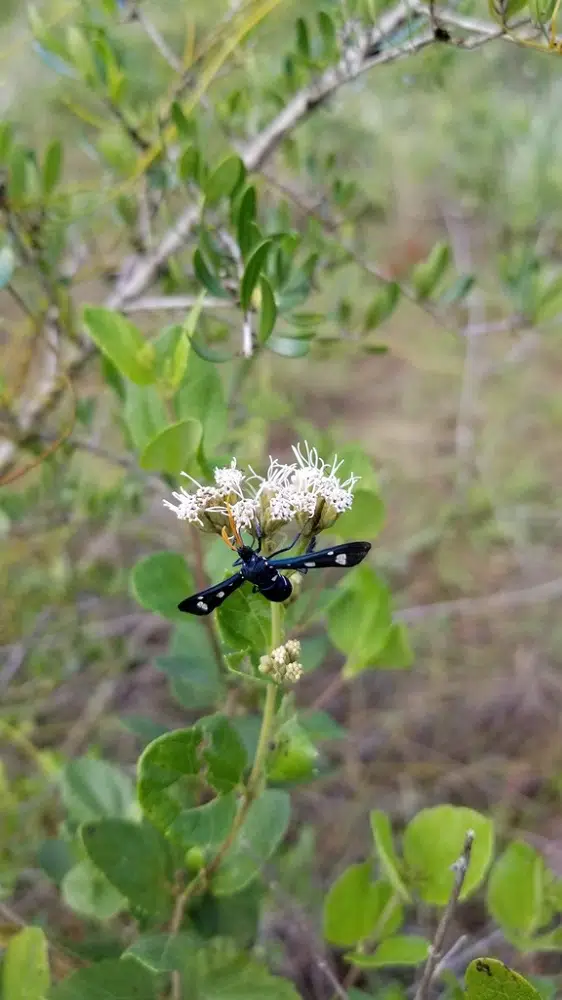
Common in Florida, this moth species (Pseudocharis minima) is often found in tropical hardwood hammocks and pine rocklands.
Lesser Wasp moths are characterized by an almost entirely black body. They have black wings and a black body with a few white marks and brown antennae.
This is an old species first described in 1867. At that time, they were known consumers of Christmas berries.
Eggs of the species are seen on the green leaves of Christmas berries. They have an off-white color and a round shape.
Pupae are brown and also seen consuming the leaves of Christmas berries.
14. Grape Root Borer Moth

This moth (Vitacea polistiformis) is known as the Grape moth. The species is common in the US, particularly in Florida.
One of their physical traits is the resemblance to paper wasps. Grape moths are mostly brown.
They have yellow bands on the abdomen.
They are known for living in grape vines at ground level. Grape moths eventually kill vines.
Considerable pest management efforts include removing all weeds around the vines constantly.
Other measures can even include covering the vines or using moth traps that are based on grape bait.
15. Pellucid Hawkmoth
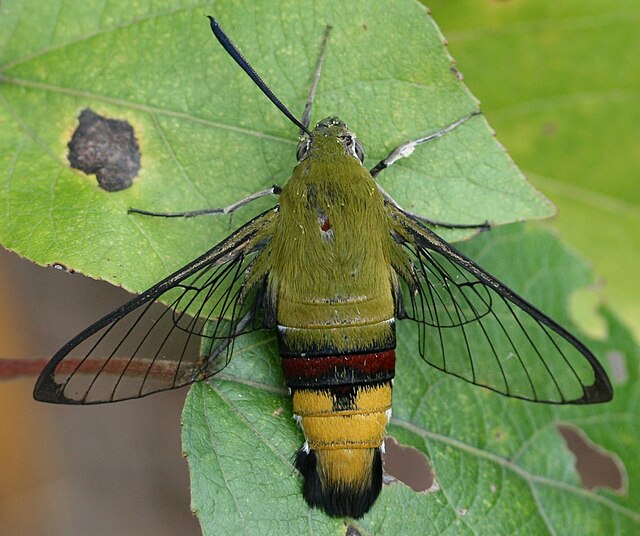
Pellucid Hawkmoths (Cephonodes hylas) are common in Australia, Japan, and parts of Asia.
It mostly resembles bumblebees with a color that’s a combination of black and either yellow or green. This moth is considerably larger than most bumblebees.
The moth is known to consume gardenias and pavetta plants as larvae.
Known for its large size, this moth is one of the largest in Australia. Its wingspan expands up to 65mm albeit most moths have an average wingspan of 50mm.
16. Ailanthus Webworm Moth

This moth species (Atteva aurea) is native to Florida and South America. It’s recognized by its orange body with white spots and black markings around the spots.
Known as colorful moths, they expanded to Florida from South America. The species followed the Tree of Heaven to spread to Southern parts of North America.
These moths are considered invasive species. Studies show that Ailanthus Webworm Moth larvae eat both the bark and the leaves of these trees.
Adult moths are also interested in flowers. They are known for their role as pollinators and they can be seen during the day as these moths are diurnal.
17. Riley’s Clearwing Moth

These moths (Synanthedon rileyana) are known for resembling yellowjackets. They even have a similar smaller size compared to other moths to resemble yellowjackets.
Coloring is black and yellow in horizontal stripes. Antennae are black while the wings are brown and slightly transparent.
The species is known as invasive for the Carolina horsenettle as larvae.
Preferred habitats include sandy soils. These moths are often found in crops which makes them an invasive species.
Riley’s Clearwing moth is often found in corn crops that have mixed fruit-bearing plants such as Carolina horsenettle.
18. Yellow-banded Wasp Moth

Yellow-banded Wasp Moths (Syntomeida ipomoeae) get their name from their resemblance to yellowjackets. These moths have a black and yellow body of orange and yellow-banded body.
Their wings are black showcasing white polka dots. First described in 1839, this is one of the oldest moth species in Florida and South Georgia.
The moths have long wings which can expand to a maximum of 43mm on average.
Known for feeding themselves in-flight, these moths are often seen around Florida flowers such as Ipomoea.
Moths of the Yellow-banded genus are known for a long flight season. They are active from the beginning of April until the end of October.
19. American Hornet Moth

The American Hornet Moth (Sesia tibiale) has a common black and yellow appearance. It mostly resembles hornets.
Common habitats of the moths include most of the US, especially Florida and Arizona. However, the species has reached Canada as well.
American Hornet moths are considered an invasive species and a potential killer of tree species such as ash, lilac, poplar, and aspen.
These moths can live up to 2 years. This interval includes its larval stages.
American Hornet moth larvae grow in tree barks. A sufficient number of eggs laid in tree bark will eventually hinder proper tree development.
These moths have also been shown to eat the tree roots of host trees. This is why all trees affected by these moths eventually die.
20. Western Poplar Clearwing Moth
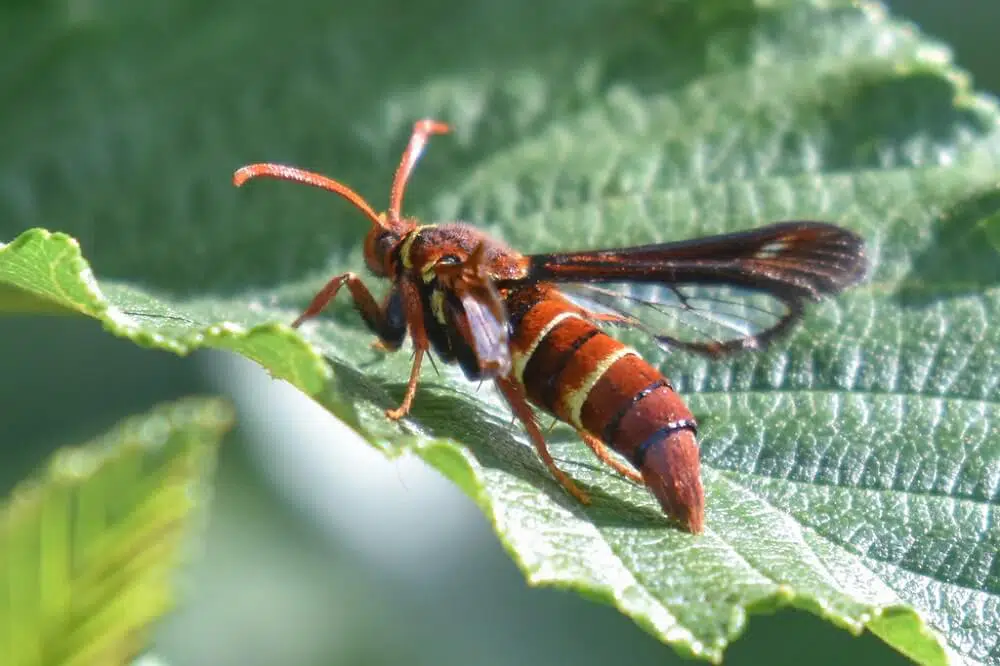
Western Poplar Clearwing moths (Paranthrene robiniae) are common in the US. They are common in desert areas and around the Rocky Mountains.
It resembles the Western Honey Bee with black and yellow bands across its body.
This species can be invasive, especially when it nests under tree bark similar to paper wasps. These moths are known to choose trees that have already been attacked by wood-eating beetle species.
Girdling and hindered tree growth is a direct result of these moths that are considered pests of poplar.
These moths are also known to settle in willows whenever they cannot find poplar.
However, poplar is preferred as the tree is eaten by larvae to a large extent.
As soon as larvae hatch, they start eating through poplar.
Even a small larvae invasion of a tree can have a large impact since Western Poplar Clearwing moth larvae spend 2 summers on the same tree.
21. Eastern Carpenter-bee Hawkmoth

The species of moth mimics carpenter bees with its black and yellow abdomen and yellow thorax.
Eastern Carpenter-bee Hawkmoth (Sataspes xylocoparis) lives in the woodlands of Vietnam, Thailand, China, and other Asian countries.
These moths have a wingspan of up to 70mm in the case of females and up to 58mm in the case of males.
The species is diurnal, like most moths that resemble bees and wasps.
Larvae eat Dalbergia benthami. Adults are known for eating the pollen of Lespedeza.
This species is highly common in urban woodlands as often spotted near Shanghai. Feeding time is the best time to see a live Eastern Carpenter-bee Hawkmoth.
This species is diurnal. Most moths are seen seeking flowers as food sources until 10 AM.
Further Reading: